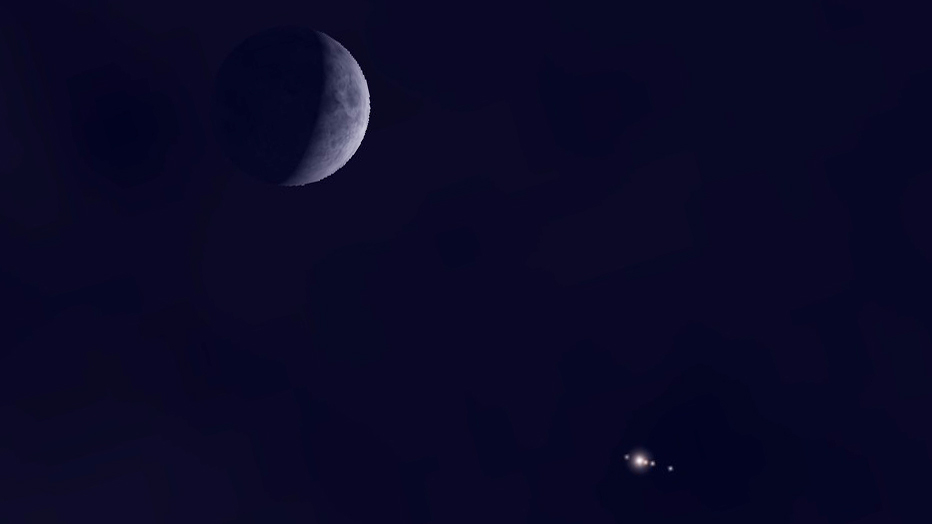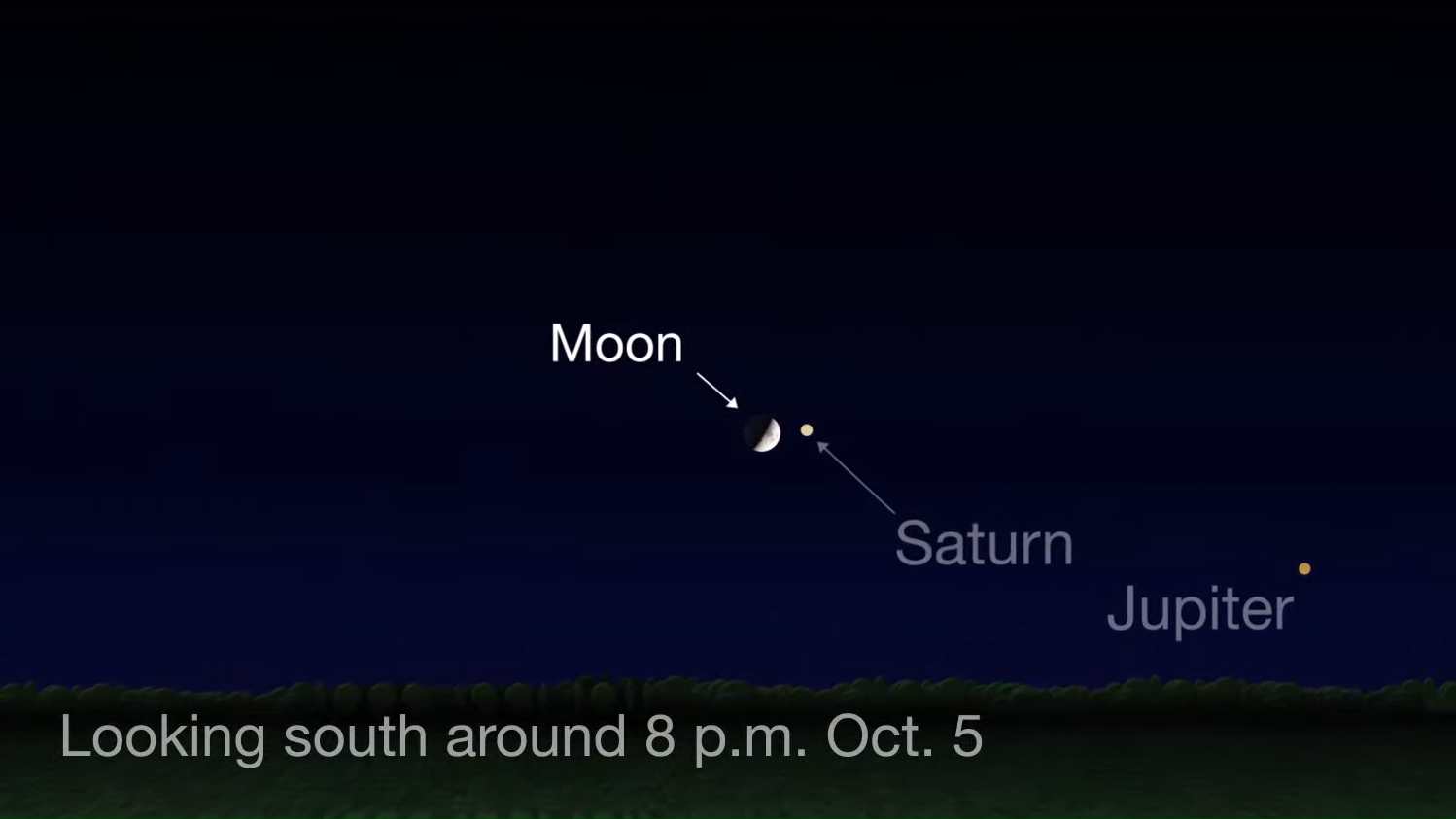
This week the moon is going to rendezvous with two bright "superior" planets. A superior planet is one that is located in an orbit around the sun that is beyond that of Earth. The two superior planets of interest this week are Jupiter and Saturn. The moon will pay Jupiter a visit on Thursday evening (Oct. 3), followed two nights later by a visit with Saturn on Saturday (Oct. 5).
Of course, these close alignments are merely an illusion of perspective. Our moon is much closer to us than it is to either Jupiter or Saturn. As it moves in its orbit around us, the moon appears to travel in an easterly direction across the sky at roughly its own apparent diameter (one-half degree) each hour, or approximately 12 degrees per day. Currently, Jupiter is located in the nonzodiacal constellation of Ophiuchus, the Serpent Holder, while Saturn resides among the stars of Sagittarius, the Archer. These two planets are separated by 25 degrees. They'll be getting a lot closer to each other in the months to come.
As we have noted in the past, your clenched fist held at arm's length measures roughly 10 degrees in width, so Jupiter and Saturn are separated by about 2.5 fists. So, it will take the moon two days to traverse this much sky — the gap that separates Jupiter and Saturn.
Related: The Brightest Visible Planets in October's Night Sky: How to See them (and When)
Thursday's "dynamic duo"
Thursday night's pairing off between the moon and Jupiter will be an eye-catching sight, which probably will attract the attention of even those who don't normally spend much time admiring the night sky. Beginning about 45 minutes after sunset, cast your eyes about a quarter of the way up from the southwest horizon. There you will find a wide crescent moon hovering only about 1.5 degrees to the upper left of brilliant Jupiter, a "marvelously close" conjunction, Fred Schaaf, who pens the "Sun, Moon & Planets" column for Sky & Telescope magazine, noted in the October 2019 issue.
And if you use a telescope or even steadily held binoculars, you can also catch a view of all four of Jupiter's famous Galilean moons, first viewed in 1610 by the astronomer Galileo Galilei using his crude homemade telescope. One of these natural satellites will appear by itself on one side of Jupiter. That will be Ganymede. Meanwhile, on the opposite side of the planet will be the three other satellites: Io, Europa and Callisto.
If you plan to look for the moon and Jupiter on Thursday, be sure to look early! Jupiter will set by around 9:50 p.m. local daylight time, followed about 15 minutes later by the moon.
Get the Space.com Newsletter
Breaking space news, the latest updates on rocket launches, skywatching events and more!

Saturday: Moon pairs off with Saturn
Two nights later, on Saturday evening (Oct. 5), the moon will team up with the ringed wonder of the solar system, the planet Saturn. The moon will be a little more than half illuminated, since the moment of first-quarter phase will have occurred around midday. So, it will be a waxing gibbous moon that will be hovering in the general vicinity of Saturn. Just look about 2 degrees to the moon's upper right, and you'll see a bright yellowish-white "star" shining with a steady, sedate glow. That will be Saturn.
Interestingly, among the naked-eye planets, we have Venus and Jupiter, which are noteworthy for their great brilliance, while Mars stands out because of its distinct orange-yellow tinge. Mercury acquired its name because it's a speed demon, moving rapidly against the star background — like the messenger of the gods for which it's named. But until its rings were discovered, Saturn was a planet that didn't seem to have anything that would call attention to it. It certainly was bright, and it seemed to move very slowly against the background stars, which is probably why it acquired its name. The Roman god Saturn was associated with the Greek god Kronos, the god of time.
But when a telescope or large binoculars with a magnification power of 20x or more is trained on Saturn, one immediately sees that here is a planet that stands out among the others, thanks to its magnificent system of rings. Like the four big moons of Jupiter, the rings of Saturn were first seen by Galileo, though because he was using a crude telescope, he could not make out what the rings were. As seen through his telescope, Saturn seemed to have a bulging shape. Galileo at first thought the bulges were caused by two motionless moons. But when Saturn turned its rings edgewise toward Earth, the "moons" completely vanished, and Galileo was faced with a mystery he never solved.
At this time of year, observers can easily see the rings, even using small instruments, because they are tilted 25 degrees to our line of sight. They are composed of countless billions of icy particles. If you have a moderate-size (6 inches) telescope or a large one (12 inches or more), use 150- to 300-power eyepieces for the best views. Even for a veteran observer like me, a view of Saturn is a "Wow!" experience, and I've seen it through a variety of different instruments, probably hundreds of times.
On Saturday night, Saturn and the moon will be in the south-southwest part of the sky about an hour after sundown. Saturn will set around 11:30 p.m. local daylight time, followed about 20 minutes later by the moon.
Observe ... and learn about the moon
And one final note: Did you know that Saturday is also International Observe the Moon Night? According to NASA, "It is a worldwide celebration of lunar science and exploration, celestial observation, and our cultural and personal connections to the Moon. One day each year, everyone on Earth is invited to observe, learn about, and celebrate the Moon together." For more details, go to moon.nasa.gov/observe-the-moon.
- Rare Photos: Jupiter's Triple-Moon Conjunction in Pictures
- 'Earthshine' Lights the Way to a Saturn Moon in Stunning Night-Sky Photo
- Jupiter Shines Over New York City in Gorgeous Skywatcher Photo
Joe Rao serves as an instructor and guest lecturer at New York's Hayden Planetarium. He writes about astronomy for Natural History magazine, the Farmers' Almanac and other publications, and he is also an on-camera meteorologist for Verizon FiOS1 News in New York's lower Hudson Valley. Follow us on Twitter @Spacedotcom and on Facebook.
Join our Space Forums to keep talking space on the latest missions, night sky and more! And if you have a news tip, correction or comment, let us know at: community@space.com.

Joe Rao is Space.com's skywatching columnist, as well as a veteran meteorologist and eclipse chaser who also serves as an instructor and guest lecturer at New York's Hayden Planetarium. He writes about astronomy for Natural History magazine, Sky & Telescope and other publications. Joe is an 8-time Emmy-nominated meteorologist who served the Putnam Valley region of New York for over 21 years. You can find him on Twitter and YouTube tracking lunar and solar eclipses, meteor showers and more. To find out Joe's latest project, visit him on Twitter.









